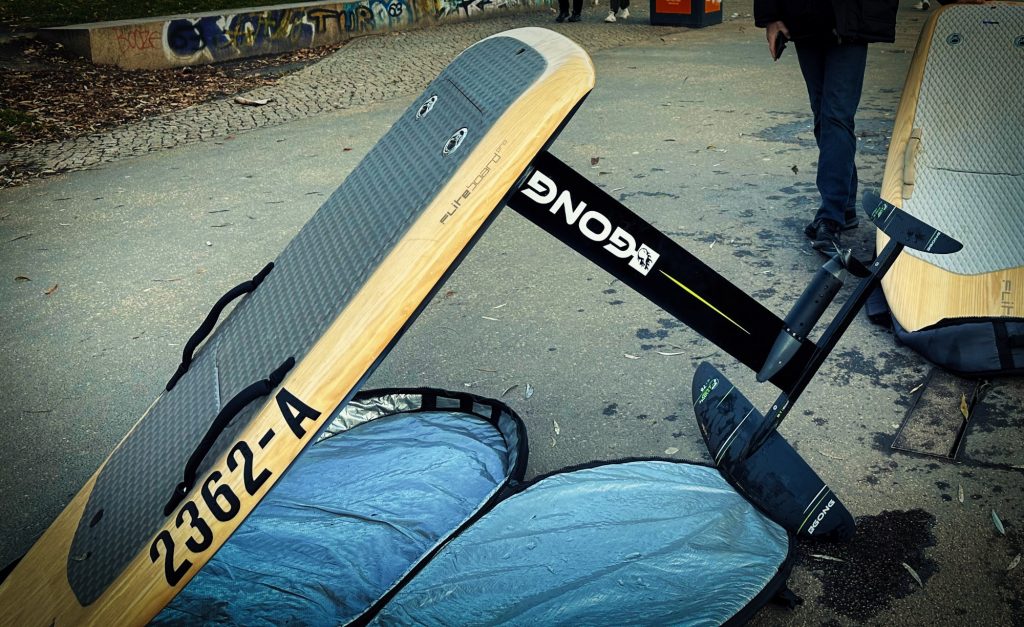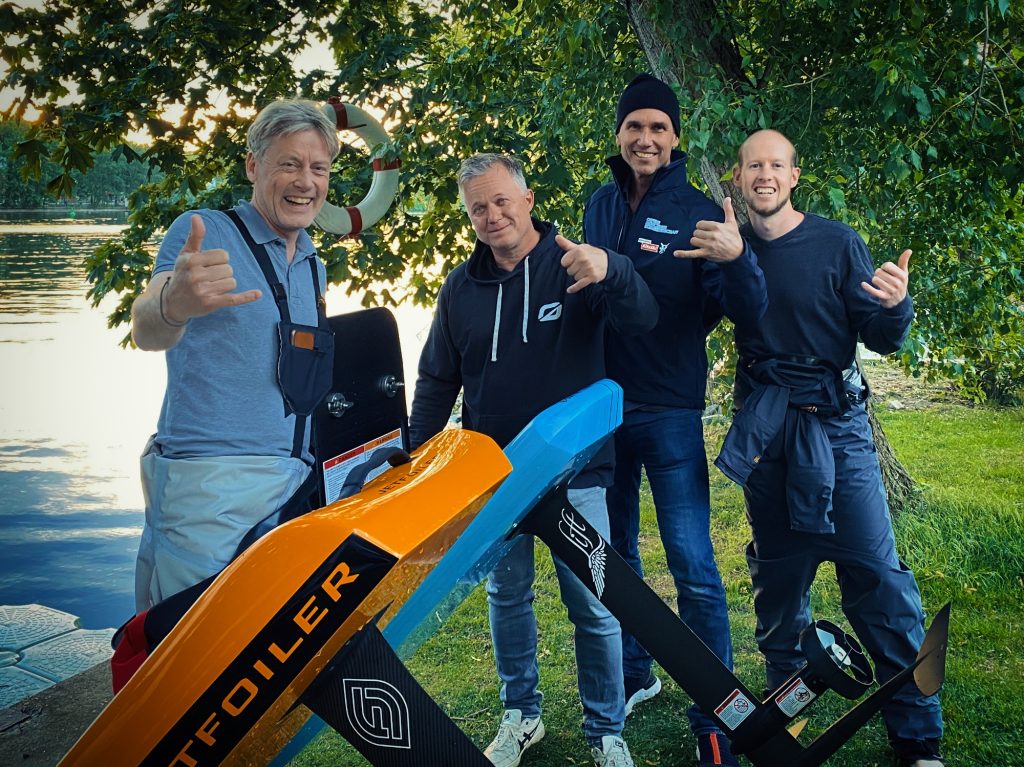If you want to build an eFoil yourself, you should plan your DIY E-Foil project thoroughly. Here is a first rough guide to the board, mast, drive and more.
Due to the sometimes high prices of eFoils, some people want to build an E-Foil themselves. In the picture above you can see a premium eFoil from Aerofoils next to the legendary rifle case DIY E-Foil from Julian G. While the Audi e-tron foil costs just under EUR 16,000, Julian has invested less than 25 percent of that.
But the man is very talented. Not only is the rifle case eFoil very difficult to ride, but together with his friend, the two of them brought a lot of technical know-how to the table.
Various DIY E-Foil approaches

In the picture above you can see two DIY approaches that couldn't be more different. The spartan rifle case eFoil by Julian and the luxury eFoil DIY by Christian. While Julian wanted to save costs, Christian focused on the highest quality down to the last detail.
If you want to build an eFoil yourself, you should first decide which approach you want to take:
- Cost vs. design
- Do everything yourself or rely on kits
- Performance of the motor
- Which battery and remote control
- Mast and wings
How much does it cost to build an eFoil yourself?
That depends very much on which approach you choose. Roughly speaking, the prices for building an eFoil yourself are between EUR 2,000 and EUR 6,000. This does not even include the working time.
If you decide to build an eFoil yourself, you should definitely enjoy building it. If you only do it to save money and don't have the right know-how, you will quickly become frustrated.

Building your own eFoil is a fascinating project, but it does require a certain amount of technical expertise and care. Here is a first rough guide.
Simple DIY eFoil instructions
This is an initial overview to describe a DIY eFoil project in more detail.
1. Board
Design and planning
- Shape and size: The choice of shape and size of the board depends on your weight and riding style. A longer and wider board offers more stability, but is less agile.
- Choice of material: Commonly used materials are EPS foam for the core, reinforced with fiberglass or carbon fiber. These materials offer a good mix of strength, weight and durability.
Manufacturing
- Shape the core: Cut the EPS foam into the desired shape. This can be done manually or with CNC machines.
- Laminating: Cover the core with fiberglass or carbon fiber and resin. This process requires several layers and careful curing.
Use an existing board
If you want to make things easier, you can use an existing board. Either a used eFoil board. This has the advantage that the battery compartment and mast passage are already in place. Or an old surfboard. In this case, however, you will have to build the battery compartment and the passage with mast reinforcement yourself.

In the picture you can see an eFoil self-made by our trainer Jan. He used an old Fliteboard surfboard for this model. He built the mast, drive and battery himself.
2. Mast
Material and construction
- Selection: Aluminum is a common choice as it is robust and relatively light. Carbon fiber offers greater strength at a lower weight, but is more expensive.
- Attachment to the board: A strong connection to the board is crucial. Use a sturdy mounting plate and make sure the connection points are reinforced.
The mast is best purchased from a foil supplier without a motor. The motor must then be mounted here and the cables routed through the mast.
3. Drive
Motor and propeller
- Motor selection: A waterproof, brushless motor that has been specially developed for use in water is necessary. The power of the motor should be matched to the weight of the rider and the desired speed.
- Propeller design: The propeller should be efficient and matched to the motor. Strike the right balance between thrust and energy efficiency.
Designing a propeller yourself will be too complicated for most people. You can also simply use a propeller from an eFoil manufacturer. For example, the Fliteboard propeller. If you want to ride waves with your eFoil, you should use a Flite folding propeller.
Mounting
- Mounting: The motor is attached to the lower end of the mast. This mounting must be secure and watertight.
There are plenty of waterproof, brushless electric motors available on the Internet. In our second part, we take a closer look at the various models and describe how to mount the motor.
4. Battery
Selection and safety
- Capacity: Choose a battery that offers sufficient capacity for the desired riding time. Lithium-ion (Li-Ion) batteries are a common option.
- Waterproof housing: The housing must be completely waterproof. Use gaskets and check the housing regularly for water tightness.
- Safety precautions: Integrate safety features such as overload protection and temperature monitoring to minimize risks. Battery management software (BMS) systems are available for this purpose.
Building a battery yourself requires a great deal of experience and care. However, in the "build your own efoil" community (more on this below) there are also private providers who can do this part for you. More about this in our 2nd part.
5. Remote control
Design and function
- Design: A hand-held, waterproof remote control is standard. It should be ergonomic and remain easy to operate even in the water.
- Features: In addition to speed control, additional functions such as a battery status display, emergency stop switch and speed limiter can be integrated.
Signal transmission
- Radio system: A reliable and interference-resistant radio system is essential. Ensure sufficient range and minimal delay.
Only very few people build their own remote control. There are various suppliers such as Maytech. More on this in our 2nd part.
Additional considerations
- Detailed planning: Create detailed plans and drawings of all components before you start manufacturing.
- Test phase: After completion, a comprehensive test phase is necessary to ensure functionality and safety.
- Legal framework: Find out about legal requirements and safety regulations in your region.
Building an DIY eFoil is a challenging project that requires not only manual skills, but also a good understanding of electrical engineering and materials science. It is advisable to seek advice from experts in the community throughout the process or to refer to existing building instructions and experience reports. Safety should always come first, both during construction and when using the eFoil.
Help with building your own DIY eFoil
Our friend Merten from Los Angeles started building his own eFoil early on. I myself had the opportunity to test his DIY eFoil in May 2018.
Unfortunately, I wasn't very successful, as you can see in the following video from the E-SURFER YouTube channel:
Well Merten is not only talented at building eFoils himself, he also started sharing his knowledge and building a DIY eFoil community very early on. Originally called eFoils.builders, the forum for DIY eFoil building can now be found at Foil.zone.
In this forum you will find everything you need to know about building your own eFoil. However, you will need to bring some time to work your way through hundreds of topics.

In the picture above, next to the E-SURFER store in Berlin, you can see Merten, the founder of eFoil.builders, wearing a cap. And on the far left is none other than the father of eFoil. Professor Jakob Kuttenbeuler, who developed the first eFoil together with students back in 2009 with the Evolo project.
Build your own eFoil - Part 2
This article is a first introduction to DIY eFoil. It replaces some very old articles from the early days of E-SURFER around 2017.
Our trainer Jan, who has already built several eFoils himself, did write a sequel with more details in part 2.


 17 min read
17 min read